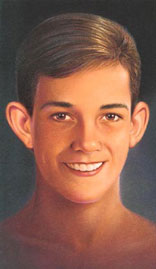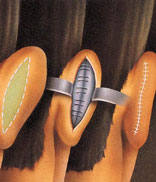Ear Pinning Surgery (Otoplasty) Washington DC
 Dr. Stephen B. Baker typically performs ear surgery (otoplasty) to set prominent ears back closer to the head or to reduce the size of large ears. If you are considering ear surgery for yourself or your child, this information will give you a basic understanding of the procedure: when it can help, how it is performed, and what results you can expect.
Dr. Stephen B. Baker typically performs ear surgery (otoplasty) to set prominent ears back closer to the head or to reduce the size of large ears. If you are considering ear surgery for yourself or your child, this information will give you a basic understanding of the procedure: when it can help, how it is performed, and what results you can expect.
What is Otoplasty?
Otoplasty, also known as ear pinning surgery, is a cosmetic procedure that adjusts the size, shape, or position of the ears to achieve a balanced and natural appearance. Patients who are self-conscious about prominent or uneven ears can benefit from this procedure, which is tailored to suit individual facial symmetry.
Prominent Ears
Patients seek ear surgery due to concerns about prominent or protruding ears. For these cases, otoplasty, or ear pinning surgery, can effectively address the shape and position of the ears, creating a more balanced appearance.
Other Ear Concerns
In addition to prominent ears, ear surgery can correct a range of other ear shapes and concerns:
- Lop Ear: Where the ear tip folds down and forward.
- Cupped Ear: Characterized by a smaller-than-normal ear size.
- Shell Ear: Missing natural folds or curves in the outer rim.
Dr. Baker also addresses large or stretched earlobes and lobes with deep creases or wrinkles. He can reconstruct a natural-looking ear for individuals born without ears or those who have lost an ear due to injury.
Infant Nonsurgical Ear Correction (EarWell)
For information on nonsurgical correction options for infants, please refer to the EarWell section of our website.
Benefits of Otoplasty
- Experience a boost in self-esteem following otoplasty and feel more comfortable with your appearance.
- Improve facial harmony by addressing ear shape or positioning that may distract from other facial features.
- Get long-lasting results; the adjustments made are typically permanent.
 Am I a Candidate for Ear Surgery?
Am I a Candidate for Ear Surgery?
This procedure is commonly performed on children between six and fourteen, as ears are nearly fully grown by age four. Completing the surgery at a younger age can help children feel more confident and avoid unwanted attention about their appearance. However, the cartilage must be strong enough to hold the sutures used to create the new shape.
Ear surgery on adults is also possible, and there are generally no additional risks associated with ear surgery on an older patient.
What to Expect during Otoplasty
For children, Dr. Baker performs ear surgery as an outpatient procedure in a hospital with pediatric anesthesiologists, and for adults at Georgetown University Hospital (Washington D.C.), Inova Fairfax Hospital (Falls Church, VA), or an ambulatory surgical facility (McLean, VA). Older patients should arrange for someone to drive them home after their surgery and to help them out for a day or two.
Ear surgery usually takes about two hours, although complicated procedures may take longer. The technique will depend on the problem.
One of the more common techniques involves making a small incision in the back of the ear to expose the ear cartilage. Dr. Baker then sculpts the cartilage and bends it back toward the head. Non-removable stitches help maintain the new shape. In most cases, ear surgery leaves a faint scar on the back of the ear that fades with time. Even when only one ear appears to protrude, surgery is usually performed on both ears to optimize postoperative symmetry.
Most patients, young and old alike, are thrilled with the results of ear surgery. However, keep in mind the goal is improvement, not perfection. Do not expect both ears to match perfectly; perfect symmetry is both unlikely and unnatural in ears.
Anesthesia
If your child is young, Dr. Baker recommends general anesthesia. This way, the child will sleep through the operation, and the anesthesiologist will establish a protected airway, which is the safest option. For older children or adults, Dr. Baker may prefer to use local anesthesia combined with a sedative.
Recovery
Adults and children are usually up and around within a few hours of surgery and can go home the same day. The patient’s head will be wrapped in a bulky bandage immediately following surgery to promote the best molding and healing. The ears may throb or ache a little for a few days, but medication can relieve this.
Within one week, the bulky bandages will be replaced by lighter head dressing similar to a headband. Follow Dr. Baker’s directions for wearing this dressing, especially at night. Sutures usually dissolve in about two weeks.
Any activity where the ear might be bent should be avoided for a month. Most adults can go back to work about five days after surgery. Children can return to school in approximately seven days if they are careful about playground activity. You may ask your child’s teacher to watch the child for a few weeks.
Why Choose Dr. Baker for Ear Surgery
Dr. Stephen B. Baker is a plastic surgeon in Washington, DC. He teaches at the MedStar Georgetown Department of Plastic Surgery and serves as the Medical Director of the Inova Children’s Hospital Craniofacial Anomalies Program. As the Director of the MedStar Georgetown Center for Facial Restoration, Dr. Baker is known for his expertise in ear surgery and facial aesthetics.
With advanced training in plastic surgery, maxillofacial surgery, and craniofacial surgery, Dr. Baker has the specialized skills to assess each patient’s unique facial structure and needs thoroughly. He has authored numerous peer-reviewed publications on ear anomalies, reflecting his commitment to advancing care in this field.
Dr. Baker’s extensive knowledge allows him to offer a full range of solutions, ensuring personalized and effective treatment options for each patient.
Cost of Otoplasty
The cost of otoplasty varies based on factors like surgical complexity and the extent of correction needed. During your consultation, Dr. Baker’s team will provide a detailed cost estimate and discuss financing options to make this procedure accessible.
Consult with Dr. Stephen B. Baker
If you’re considering otoplasty, schedule a consultation with Dr. Stephen B. Baker in Washington, DC. With extensive experience in cosmetic facial procedures, Dr. Baker will discuss your goals, evaluate your candidacy, and create a tailored treatment plan to help you achieve a more balanced, confident appearance.
Frequently Asked Questions
As Featured In






